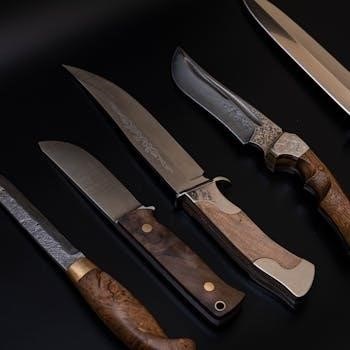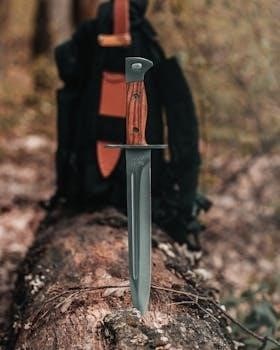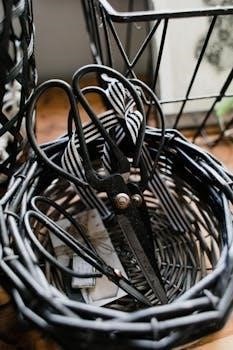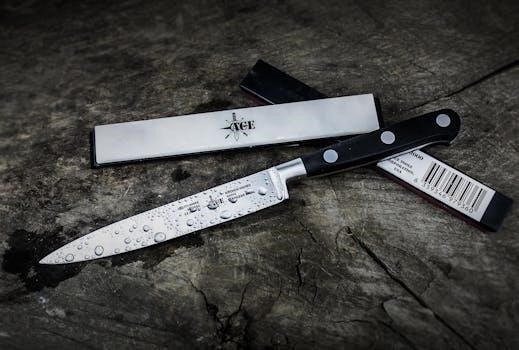Knife steel charts in PDF format are essential resources. They offer comprehensive data on steel properties, composition, and applications for knives.
Understanding Knife Steel Composition
Understanding the composition of knife steel is crucial for determining its performance characteristics. Knife steels are primarily alloys of iron, carbon, and other elements like chromium, molybdenum, vanadium, and nickel. Carbon content is vital, directly impacting hardness and edge retention; higher carbon generally leads to greater hardness but can reduce toughness; Chromium enhances corrosion resistance, forming a protective layer. Molybdenum increases strength and toughness, while vanadium contributes to wear resistance and grain refinement. Nickel improves toughness. Each element plays a crucial role, and the specific combination dictates the steel’s suitability for various knife applications. Analyzing the percentage of each element reveals a steel’s potential strengths and weaknesses. For example, a high-carbon, high-chromium steel will likely be very hard and corrosion-resistant but may be less tough than a low-carbon steel with added nickel. Therefore, careful examination of the composition is essential for informed knife selection, ensuring it aligns with the intended use and performance requirements, whether it’s for everyday carry, hunting, or culinary purposes. This understanding allows for better interpretation of knife steel charts and informed purchasing decisions.

Key Properties of Knife Steels
Key properties of knife steels include hardness, toughness, wear resistance, and corrosion resistance. These factors determine a knife’s overall performance.
Hardness (HRC)
Hardness, measured on the Rockwell C scale (HRC), is a crucial property of knife steel. It indicates the steel’s resistance to indentation and abrasion, directly affecting edge retention. A higher HRC value generally means the blade will stay sharp longer, requiring less frequent sharpening. However, increased hardness can also lead to decreased toughness, making the blade more susceptible to chipping or breaking, especially under heavy use or impact. The ideal hardness for a knife steel depends on the intended application; knives designed for delicate tasks might benefit from slightly lower hardness for increased flexibility, while knives used for more demanding cutting tasks will usually perform better with a higher hardness rating. Therefore, understanding the trade-offs between hardness and toughness is essential when selecting a knife or evaluating its steel. Factors like heat treatment and the presence of specific alloying elements significantly influence the achievable hardness of a particular steel grade. Consulting knife steel charts provides valuable information on HRC values for various steels, aiding informed decision-making.
Toughness
Toughness refers to a knife steel’s ability to absorb energy and resist fracturing or chipping under stress. It is a critical property, especially for knives that will be subjected to heavy use, impact, or prying tasks. A tough steel can withstand significant force without breaking, making it more reliable and durable in demanding situations. Unlike hardness, which focuses on resistance to indentation, toughness addresses the steel’s ability to deform plastically before fracturing. Factors influencing toughness include the steel’s composition, grain size, and heat treatment. Steels with higher carbon content tend to be harder but less tough, while steels with alloying elements like nickel and manganese often exhibit improved toughness. The heat treatment process, particularly tempering, plays a crucial role in optimizing the balance between hardness and toughness. A properly tempered steel will possess a good combination of both properties. When selecting a knife, consider the intended use and prioritize toughness if the knife will be used for tasks that involve significant stress or potential impact. Knife steel charts often provide information on the relative toughness of different steels, although direct numerical values are less common than HRC ratings. Understanding the relationship between toughness and other properties is essential for choosing the right knife for your needs. Look for steels known for their ability to withstand abuse without failing.
Wear Resistance
Wear resistance describes a knife steel’s ability to resist abrasion and erosion during use. This property is crucial for maintaining a sharp edge over an extended period, reducing the frequency of sharpening. A steel with high wear resistance will retain its sharpness longer, even when cutting through abrasive materials. Several factors contribute to a steel’s wear resistance, including its hardness, the presence of hard carbides in its microstructure, and the overall composition. Harder steels generally exhibit better wear resistance, as they are less susceptible to scratching and deformation. The presence of carbides, such as chromium carbides, vanadium carbides, and tungsten carbides, further enhances wear resistance by providing hard particles that resist abrasion. The type and volume of these carbides significantly impact the steel’s performance. Steels with a higher volume of hard carbides tend to have superior wear resistance. However, increasing the carbide content can sometimes compromise toughness, so a balance must be achieved. Knife steel charts often provide information on the relative wear resistance of different steels, although it may not be quantified directly. Instead, the chart may indicate the presence and amount of carbide-forming elements in the steel’s composition. When selecting a knife, consider the types of materials you will be cutting and prioritize wear resistance if you need a knife that holds its edge for a long time. Steels known for their high wear resistance are often preferred for demanding cutting tasks.
Corrosion Resistance
Corrosion resistance refers to a knife steel’s ability to withstand rust and other forms of environmental degradation. This property is especially important for knives used in humid or marine environments, or those that come into contact with corrosive substances like acids or salts. Stainless steels are specifically designed to offer high corrosion resistance, primarily through the addition of chromium. A chromium content of at least 10;5% is generally required for a steel to be considered “stainless.” The chromium forms a passive layer of chromium oxide on the steel’s surface, which protects the underlying metal from corrosion. This layer is self-healing, meaning that if it is scratched or damaged, it will quickly reform in the presence of oxygen. Other elements, such as nickel, molybdenum, and nitrogen, can further enhance corrosion resistance. Nickel improves resistance to acids and alkalis, while molybdenum enhances resistance to pitting corrosion. Nitrogen increases the steel’s strength and also contributes to corrosion resistance. Knife steel charts often provide information on the chemical composition of different steels, including the percentage of chromium and other alloying elements. This information can be used to assess the relative corrosion resistance of different steels. However, corrosion resistance is not solely determined by the chemical composition. Other factors, such as the steel’s heat treatment and surface finish, can also play a role. For example, a properly passivated stainless steel will have a higher corrosion resistance than one that has not been passivated. Similarly, a polished surface will be more resistant to corrosion than a rough surface. When selecting a knife, consider the environment in which it will be used and prioritize corrosion resistance if necessary. High corrosion resistance is particularly important for knives used in saltwater or acidic environments.

Common Knife Steels and Their Equivalents
Understanding common knife steels and their equivalents is crucial for informed knife selection and performance expectations. This knowledge aids comparison.
High Carbon Steels
High carbon steels are known for their exceptional hardness and edge retention, making them popular choices for knives that require a keen cutting edge. These steels typically contain a higher percentage of carbon (usually above 0.5%) compared to other steel types. This increased carbon content allows for better hardening during heat treatment, resulting in a blade that can hold its sharpness for extended periods. Examples of high carbon steels commonly used in knife making include 1095, A2, and O1. 1095 is a simple, high-carbon steel that is easy to sharpen but can be prone to corrosion if not properly maintained. A2 is a tool steel that offers a good balance of toughness, wear resistance, and edge retention; O1 is another oil-hardening tool steel known for its fine grain structure and ability to take a very sharp edge. When selecting a high carbon steel knife, it’s important to consider the trade-offs between hardness, toughness, and corrosion resistance. While high carbon steels excel in hardness and edge retention, they may be more susceptible to rust and chipping compared to stainless steels or tougher alloy steels. Regular cleaning and oiling are essential to prevent corrosion and maintain the blade’s performance. The Radeco(Poldi) steel, similar to AISI T15, offers an alternative, though without Cobalt.
Stainless Steels
Stainless steels are prized for their excellent corrosion resistance, making them a popular choice for knives used in environments where moisture or exposure to corrosive substances is a concern. The defining characteristic of stainless steel is the presence of chromium (typically at least 10.5%), which forms a passive layer of chromium oxide on the surface of the steel, protecting it from rust and staining. There are many different types of stainless steels used in knife making, each with its own unique properties and characteristics. Common examples include 440C, AUS-8, VG-10, and S30V. 440C is a high-carbon stainless steel known for its good hardness, wear resistance, and corrosion resistance. AUS-8 is a Japanese stainless steel that offers a good balance of toughness, edge retention, and corrosion resistance, making it a versatile option for everyday carry knives. VG-10 is another popular Japanese stainless steel known for its excellent edge retention and corrosion resistance. S30V is a high-end stainless steel that offers exceptional wear resistance and edge retention, making it a favorite among knife enthusiasts. When choosing a stainless steel knife, it’s important to consider the specific alloy and its intended use. Some stainless steels may be harder and more wear-resistant than others, while others may offer better toughness or corrosion resistance. Stainless steel 310/310S provides oxidation resistance up to 2000F. Daido Steel also produces various stainless steel grades.

Reading and Interpreting Knife Steel Charts
Understanding knife steel charts requires familiarity with steel properties. Deciphering designations and data points ensures informed decisions.
Understanding Steel Designations (e.g., AISI, DIN)
Knife steel charts often use specific designation systems, such as AISI (American Iron and Steel Institute) or DIN (Deutsches Institut für Normung), to classify different types of steel. Understanding these designations is crucial for accurately interpreting the information presented in the charts. AISI uses a system of letters and numbers to indicate the steel’s composition and properties. For example, AISI 304 is a common stainless steel. DIN, a German standard, also uses a numerical system to classify steels based on their chemical composition and intended use. Familiarity with these systems allows you to quickly identify the key characteristics of a steel, such as its carbon content, chromium content, and other alloying elements. This knowledge is vital for comparing different steels and selecting the best material for a particular knife application. For instance, knowing the AISI or DIN designation can help you determine the steel’s hardness, toughness, corrosion resistance, and wear resistance, all of which are important factors in knife performance. Consulting reference tables and online resources can further aid in understanding these designations.
Finding Reliable Knife Steel Charts in PDF Format
Locating accurate knife steel charts in PDF form can be achieved through manufacturer websites and specialized knife retailer resources online.
Manufacturer Websites
Many steel manufacturers, such as Daido Steel, provide detailed datasheets on their products, often available as PDF downloads. These datasheets typically include the chemical composition, hardness, heat treatment recommendations, and typical applications for each steel grade. Radeco (Poldi), known for high-speed tool steel similar to AISI T15 (but without Cobalt), may also offer such resources. These manufacturer websites are invaluable for understanding the specific properties and potential uses of their steels in knife making. Tecofi, while primarily focused on water and industrial products, might offer relevant steel composition information too. Always verify the date of the datasheet to ensure the information is current. Checking these sites often provides the most accurate and up-to-date information on specific steel grades. This information is vital when choosing the correct steel for a particular use. This ensures your knife is safe and high quality. It is crucial to verify any online information with official sources. Be sure to review multiple sources before making a final decision.
Knife Retailer Resources
Knife retailers often compile and provide resources to help customers understand the steels used in the knives they sell. These resources may include charts, comparisons, and guides that summarize the key properties of various knife steels, such as hardness, toughness, wear resistance, and corrosion resistance. Some retailers may offer these resources in PDF format for easy download and reference. These resources are especially useful for consumers who want to compare different knife steels and make informed purchasing decisions. Retailers want to inform customers about their products. They will typically offer information regarding the knife’s balance and intended use. It’s important to note that retailer-provided information might be simplified or biased towards the steels they commonly sell. Always cross-reference information from multiple sources, including manufacturer datasheets and independent reviews, to obtain a comprehensive understanding. These resources can give you an idea of what knife is right for you. Be sure to consider the maintenance requirements of the knife. Some retailers may also include information on proper knife maintenance and care. This helps extend the life of your knife. This ensures your knife is safe and high quality.
Maintenance Requirements

Factors to Consider When Choosing a Knife Steel
Choosing the right knife steel depends on several factors. Consider the intended use and required maintenance for optimal performance and longevity.

Be First to Comment